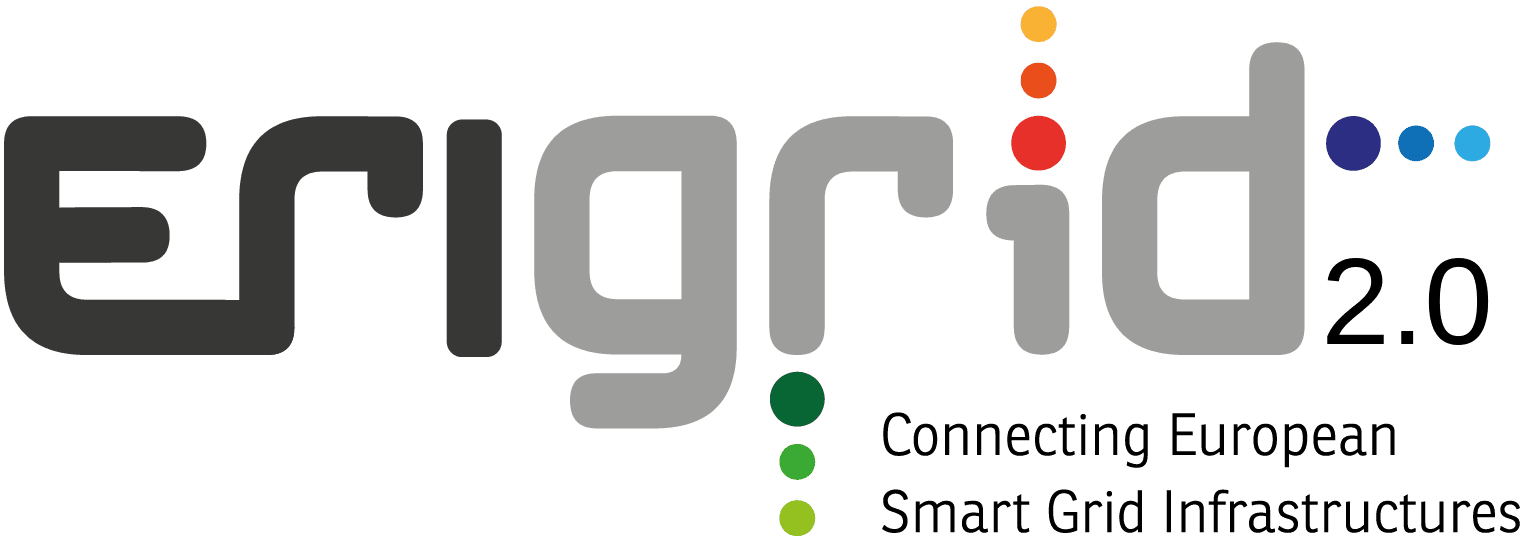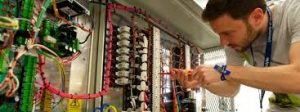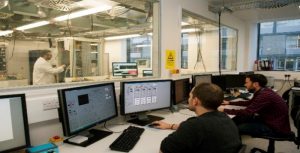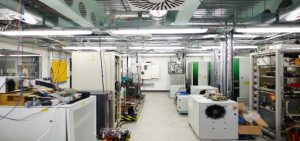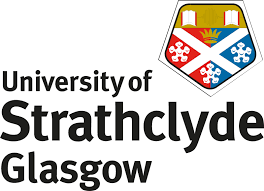
Housed in a £90m state of the art research and knowledge exchange environment, the laboratory contains a reconfigurable 400 V three-phase AC power network with multiple controllable voltage supplies and loads with flexible control systems and interfaces. The laboratory has power hardware-in-the-loop (PHIL) and controller hardware-in-the-loop (CHIL) capabilities. The network and devices are used to test and demonstrate smart grid technologies within a controlled environment, and under steady-state and abnormal conditions.
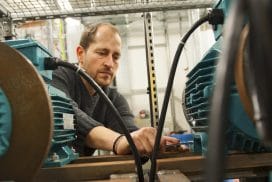
Typical areas of research include: high-fidelity real-time simulation, integrated control and communications characterisation, flexible microgrid for dynamic systems studies, emulation of converter dominated systems, flexibility services from DER and energy storage, protection evaluation, PMU test bed distributed control, pre-certification testing, islanded (and auto-islanding) power systems, and dynamic power systems (e.g. marine/emergency).
Location: Glasgow, United Kingdom
The flexible dynamic power network has four modes of operation: power hardware in the loop simulation; pre-set scenario playback; direct grid connection; and islanded system operation. The laboratory network is designed such that it can be split into three separate power islands under independent control or connected together as an interconnected system. This provides a high degree of flexibility enabling the testing for a wider range of sectors, e.g. energy, marine or transport sectors.
The power network facilities are complemented with extensive real-time power system simulation capabilities enabling augmentation of the hardware network with simulated systems, which thereby representing large power networks. Simulated systems can be linked with real substation equipment – such as measurement devices, protection relays, and communications routers – to authentically and systematically validate prototype smart grid solutions. Specific technologies underpinning the infrastructure include: real-time communications emulation, precision time-synchronisation, phasor measurement units (PMUs), and state-of-the-art protocols for data communications (such as IEC 61850).
The laboratory infrastructure has been mapped into the Smart Grid Architecture Model (SGAM) for facilitating the integration of devices and use cases under test. This allows for fast prototype development and minimises possible incompatibilities or integration issues.
In order to achieve accelerated testing, the RI is underpinned by the following main systems:
100kVA reconfigurable microgrid: The flexible microgrid is composed of controllable loads and electric machines, energy storage systems and flexible power converters as described below.

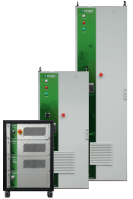 Power converters and controllable loads: A 90 kVA back-to-back, fully-controllable converter is one of the main assets of the laboratory. It allows the performance of experiments gridconnected or islanded from the grid thereby creating an island of >90 kVA. Two other power converter units of 15 kVA and 10 kVA are available that can be controlled as emulated loads or as different types of generators; these devices could also be used to form smaller islanded systems. A 50 kVA and 2 x 12.5 kVA controllable loads are also available. Induction machines, which can be operated as motors or generators, provide inertia and controllable torque. This provides a controllable and repeatable environment for systems tests, to deploy and validate new microgrid control algorithms.
Power converters and controllable loads: A 90 kVA back-to-back, fully-controllable converter is one of the main assets of the laboratory. It allows the performance of experiments gridconnected or islanded from the grid thereby creating an island of >90 kVA. Two other power converter units of 15 kVA and 10 kVA are available that can be controlled as emulated loads or as different types of generators; these devices could also be used to form smaller islanded systems. A 50 kVA and 2 x 12.5 kVA controllable loads are also available. Induction machines, which can be operated as motors or generators, provide inertia and controllable torque. This provides a controllable and repeatable environment for systems tests, to deploy and validate new microgrid control algorithms.

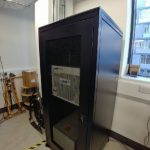 Energy Storage System: Two fully controllable energy storage sources are present in the laboratory. A Li-ion 10kWh battery controlled through a 9kW externally controlled inverter. Furthermore, a 166µF and 54Wh supercapacitor connected through a 20kW fast dynamic inverter is also present. These energy storage sources can be flexibly controlled from the real-time suite or other external control and have been used in a number of studies as a hybrid storage source for mitigating transients or optimizing the use of energy within islanded power systems.
Energy Storage System: Two fully controllable energy storage sources are present in the laboratory. A Li-ion 10kWh battery controlled through a 9kW externally controlled inverter. Furthermore, a 166µF and 54Wh supercapacitor connected through a 20kW fast dynamic inverter is also present. These energy storage sources can be flexibly controlled from the real-time suite or other external control and have been used in a number of studies as a hybrid storage source for mitigating transients or optimizing the use of energy within islanded power systems.

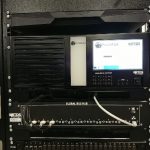 Real time simulation suite: The real-time simulation suite allows large power networks to be simulated at a resolution of 50 µs or smaller. The laboratory has an RTDS system with a combination of PB5 and Novacor processors, with a range of I/O capabilities including hard-wired analogue and digital I/O (Aurora link), DNP3, and IEC 61850 Sampled Values and GOOSE communications. Two real-time simulators from Applied Dynamics International (RTS and RTX) allow smart grid scenarios to be enacted with the laboratory, with capability for real-time data monitoring and control. The two real-time units can be used in conjunction with RTDS for high fidelity multi-rate co-simulations
Real time simulation suite: The real-time simulation suite allows large power networks to be simulated at a resolution of 50 µs or smaller. The laboratory has an RTDS system with a combination of PB5 and Novacor processors, with a range of I/O capabilities including hard-wired analogue and digital I/O (Aurora link), DNP3, and IEC 61850 Sampled Values and GOOSE communications. Two real-time simulators from Applied Dynamics International (RTS and RTX) allow smart grid scenarios to be enacted with the laboratory, with capability for real-time data monitoring and control. The two real-time units can be used in conjunction with RTDS for high fidelity multi-rate co-simulations

Other real time simulation tools include an OPAL-RT and Speedgoat real time simulation systems. A number of grid and marine system models have been created for validating on- and off-shore networks, renewable generation, and network automation. Such infrastructure has been used to test protection and control schemes under a large number of scenarios and to inform standard settings (loss of mains protection)
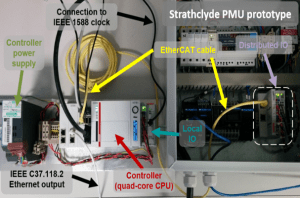 Fast data acquisition and metrology suite: High accuracy instantaneous LV voltage and current measurements can be collected at a rate of up to 10 kHz using a distributed data acquisition system. The sampling uses an absolute time reference with resolution of <100 ns. The system is modular, so additional measurement points and processing nodes can be added where required. Furthermore, the platform can also be used to deploy control functions where control functionality can be distributed at the measurement nodes. For example, multiple PMUs or IEC 61850 IEDs – supporting standardised communications protocols – can be readily deployed for monitoring and control.
Fast data acquisition and metrology suite: High accuracy instantaneous LV voltage and current measurements can be collected at a rate of up to 10 kHz using a distributed data acquisition system. The sampling uses an absolute time reference with resolution of <100 ns. The system is modular, so additional measurement points and processing nodes can be added where required. Furthermore, the platform can also be used to deploy control functions where control functionality can be distributed at the measurement nodes. For example, multiple PMUs or IEC 61850 IEDs – supporting standardised communications protocols – can be readily deployed for monitoring and control.
Integrated Communications Emulation: 
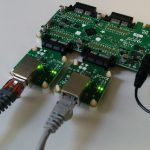 The laboratory has an integrated communications validation and emulation platform with the capability to mimic modern utility communications network infrastructure using four Nokia (formerly Alcatel-Lucent) 7705 IP/MPLS routers, including tele-protection and Ethernet interface cards. The use of custom embedded platforms and ns3 servers allows extended communications networks to be emulated in real-time.
The laboratory has an integrated communications validation and emulation platform with the capability to mimic modern utility communications network infrastructure using four Nokia (formerly Alcatel-Lucent) 7705 IP/MPLS routers, including tele-protection and Ethernet interface cards. The use of custom embedded platforms and ns3 servers allows extended communications networks to be emulated in real-time.
Platform for Large-Scale WAMPAC Systems and PMU validation: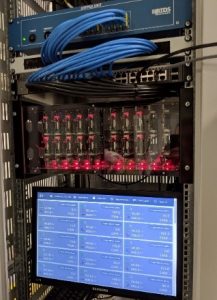
A platform for emulating 64 Phasor Measurement Units (PMUs), with data from a real-time simulation, has been developed and is available for system, technology and protocol studies. For example, drawing on sourced IEC 61850-9-2 Sampled Value data generated from our real time suite representing three-phase voltage and current measurements from over 60 power system locations, the platform has proven its ability to efficiently process the data using cost-effective ARM-based devices, outputting synchrophasor data in accordance with the IEEE C37.118.2 protocol. The platform provides the flexibility to configure the PMU class and reporting rate at run-time.
This platform can thus be additionally used for the validation of distributed control algorithms, an example of use for demonstration of frequency control within Great Britain power system is shown below.
Laboratory Integration Toolkit:
The RI is further complemented by a number of adjacent facilities that include DC power systems laboratory, HV test cells, sensors laboratory, power electronics laboratory, and superconducting technology laboratory. Interconnectivity may be utilised where experiments require it. In addition, the DPSL has comprehensive experience of operating Geographically Distributed Laboratory experiments, supporting the integrated evaluation to utilise assets located remotely from the laboratory. Additionally, the facility has a comprehensive set of simulation models, historical data sets from recorded events available in our library to support the experimental investigations.
The Dynamic Power System Laboratory offers a flexible environment to test new components or algorithms on an LV network with a variable frequency and voltage supply. Devices can be attached to the network at a number of points and with voltage and current measurements taken back to a central real-time control platform. Some example services include:
Rapid prototyping and testing of smart grid control schemes
The laboratory is well equipped to demonstrate novel centralized, decentralized, distributed and hierarchical architectural solutions for power system (for example, demand side aggregator with highly distributed portfolio providing frequency balancing ancillary service) and to rigorously test and evaluate these novel solutions. Therefore, novel prototypes can be de-risked before their adoption and deployment in industry. Furthermore, scalability assessments can be performed with the available distributed controller platform. The various modes of operation of the laboratory and the variety of power equipment provide the flexibility to represent a wide variety of smart grid configurations and scenarios.
High Fidelity Power Hardware in the Loop (PHIL) validation
The power network facilities are complemented with extensive real-time power system simulation capabilities enabling augmentation of the hardware network with simulated systems, thereby representing large complex power networks. Simulated systems can be linked with real substation equipment – such as measurement devices, protection relays, and communications routers – to authentically and systematically validate prototype smart grid solutions. The facility incorporates state of the art time delay compensation for PHIL studies enabling high fidelity validations.
Hardware in the loop testing of control, protection, and automation equipment
Using hardware in the loop testing, all primary power system equipment and assets are simulated, in real-time. It is possible to simulate arbitrary electrical networks and all the extremes of operation, including stable conditions and many different fault scenarios, such as systematically testing a range of different fault locations. However, the simulation is linked to the real commercial hardware devices under test, such as protection relays, PMUs, and measurements and communications equipment. The response of the hardware can be monitored and thereby validated, with option to perform automated tests (such as for PMUs). Wide-area control algorithms can be validated using the available micro-PMUs, the laboratory can generate real-time data from up to 64 PMUs, to enable large-scale WAMPAC systems and data analysis methods. Capabilities include emulation of wide-area networks (WANs) and Demand-Side Management participation
In this way, new schemes can be validated, adaptive features thoroughly tested, and new settings or operating guides resolved.
Validation of teleprotection using modern communications technologies
Many electrical utilities, worldwide, and implementing or planning a revolutionary shift in telecoms infrastructure: moving from conventional circuit-based networks to packet-based systems. At Strathclyde, we have pioneered techniques to validate these new technologies in the most challenging conditions to ensure that teleprotection services – the most safety and operationally critical role – are delivered correctly.
Power electronic converter performance evaluation and grid integration
The laboratory has a range of devices (converters, loads and visiting devices) with flexible control systems and interfaces. The network and devices are used to test and demonstrate smart grid technologies within a controlled environment, and under steady-state and abnormal conditions. As part of a technological university and a strong research centre, the RI benefits from the close proximity to a large number of expert researchers in electrical technologies, modelling, simulation, and experimental validation.
Integration of renewable technologies enabling low-carbon grids
The laboratory has the capability to represent different types of grid resources (renewables, grid forming converters (VSG), synchronous generation, etc.) using several controllable power electronic converters. There is also a hardware battery energy storage system, and a super capacitor that can be used for experimental validation of the integration of renewable technologies in low carbon grids. The facility can use these resources to perform marine and land based microgrid design and validation.
Multi-laboratory testing for large scale validations
Remote connection of laboratories can be performed for the validation of larger scale systems, distributed or decentralized controllers or for remotely connecting testing assets which are difficult to transport or that can present confidentiality issues.
The dynamic power systems laboratory has an excellent track record in internationally co-authored publications with transnational access users. Each project has led to high quality publications, and the most recent publications can be found here: https://pureportal.strath.ac.uk/en/equipments/dynamic-power-systems-laboratory
 The Institute for Energy and Environment (InstEE) represents one of Europe’s largest power systems and energy technology university research groups. Comprising 38 members of academic staff, over 200 research staff and students, and 18 technical and administrative colleagues, the Institute has four main research groups: Advanced Electrical Systems, High Voltage Technology, Power Electronics Drives and Energy Conversion, Wind Energy and Control. This is complemented by the Power Networks Demonstration Centre (PNDC) which hosts a fully operational HV and LV demonstration network and dedicated team of research, technical and support staff. PNDC accelerates grid-ready validation at a larger scale and higher voltage level than is possible than at the DPSL facility.
The Institute for Energy and Environment (InstEE) represents one of Europe’s largest power systems and energy technology university research groups. Comprising 38 members of academic staff, over 200 research staff and students, and 18 technical and administrative colleagues, the Institute has four main research groups: Advanced Electrical Systems, High Voltage Technology, Power Electronics Drives and Energy Conversion, Wind Energy and Control. This is complemented by the Power Networks Demonstration Centre (PNDC) which hosts a fully operational HV and LV demonstration network and dedicated team of research, technical and support staff. PNDC accelerates grid-ready validation at a larger scale and higher voltage level than is possible than at the DPSL facility.
The DPSL is based in the state-of-the-art Technology and Innovation Centre (TIC) within the University of Strathclyde. This facility, opened in July 2015, houses much of Strathclyde’s industry-facing research work. There are 45 bespoke, state of the art laboratories across the key research themes of energy, health & wellbeing, advanced manufacturing & materials, measurement science & enabling technologies, and ocean, air and space– which support innovation and research demonstration.
Induction and safety:
Induction material is available for allowing access to the building and laboratory facilities.
For safety reasons, any work involving live equipment, is not to be operated by the users themselves; experimental tests will be carried out by Strathclyde technical and research staff. Access to simulators, or other preparatory work not involving live equipment, will be granted, provided necessary reservations have been made in advance by the users by using Strathclyde’s online equipment reservation platform. The scheduling of the experiments will be agreed and booked prior to the stay according to the availability of the involved staff and equipment. Administrative documentation for the access (contract, non-disclosure agreement, etc.) will comply with ERIGrid2.0 common indications.
The access being offered includes supervision and help of Strathclyde staff:
- As a complement to the pre-access contacts between the user group and Strathclyde, the stay will start with an introductory meeting with a senior researcher for confirming the stay conditions (confidentiality, safety indications), scheduling the activities, explaining the on-site procedures, clarifying the logistics and technical details.
- Preparatory work: a laboratory technician will assist the users for the installation of the devices, electrical connections, use of the specific instrumentation, preparation of a test procedure (if necessary) on the basis of the users’ requests, and programming of the experimental conditions.
- Strathclyde researchers will support the realisation and follow-up of the experiments.
- Strathclyde researchers will support the results interpretation, data processing and analysis, and test report preparation.
- It is expected that the work undertaken at the RI is disseminated. Previous collaborative visits to the RI have resulted in reputable journal and conference publications.
Reimbursement of expenses:
User expenses for the lab access are paid by ERIGrid 2.0 (EU H2020 Programme). This includes travels to Strathclyde by plane (economy), accommodation, daily subsistence, and daily transportation during the stay.
Do you have questions left? Feel free to contact us below.
If your enquiry contains strictly confidential information, please leave your contact details below and the lab host will contact you personally.




